Related Research Articles

Indian Creek is a village, gated community, and man-made barrier island in Miami-Dade County, Florida, United States. It has 41 residential home sites and the Indian Creek Country Club. The village is part of the Miami metropolitan area of South Florida. The concentration of highly affluent people on the island has earned it the nickname "Billionaire Bunker". The population was 84 at the 2020 census. The village has its own government and law enforcement.

Islandia is an unincorporated community and former city in Miami-Dade County, Florida, United States. It is located in the upper Florida Keys on the islands of Elliott Key and other nearby keys, such as Totten Key. It was the only municipality in the Florida Keys not located in neighboring Monroe County. The population was 18 at the 2010 Census. Most residents of the city were National Park Service employees.
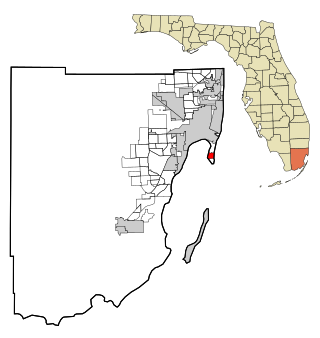
Key Biscayne is an island village in Miami-Dade County, Florida, United States. The village is part of the Miami metropolitan area of South Florida. The population was 14,809 at the 2020 census, up from 12,344 in 2010.
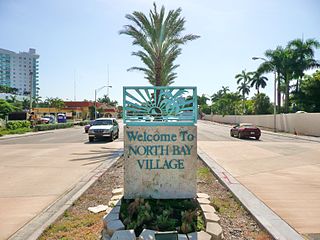
North Bay Village is a city located in Miami-Dade County, Florida. The city is part of the Miami metropolitan area of South Florida. As of the 2020 census, the city had a total population of 8,159.

North Miami is a suburban city located in northeast Miami-Dade County, Florida, United States, about 10 miles (16 km) north of Miami. The city lies on Biscayne Bay and hosts the Biscayne Bay Campus of Florida International University. Originally the "Town of Arch Creek", the area was incorporated as the "Town of Miami Shores", which was renamed the "Town of North Miami" in 1931. It was reincorporated as a city in 1953. The city is part of the Miami metropolitan area of South Florida.

Biscayne National Park is a national park of the United States located south of Miami, Florida, in Miami-Dade County. The park preserves Biscayne Bay and its offshore barrier reefs. Ninety-five percent of the park is water, and the shore of the bay is the location of an extensive mangrove forest. The park covers 172,971 acres and includes Elliott Key, the park's largest island and northernmost of the true Florida Keys, formed from fossilized coral reef. The islands farther north in the park are transitional islands of coral and sand. The offshore portion of the park includes the northernmost region of the Florida Reef, one of the largest coral reefs in the world.

Biscayne Bay is a lagoon with characteristics of an estuary located on the Atlantic coast of South Florida. The northern end of the lagoon is surrounded by the densely developed heart of the Miami metropolitan area while the southern end is largely undeveloped with a large portion of the lagoon included in Biscayne National Park.

Key Biscayne is an island located in Miami-Dade County, Florida, located between the Atlantic Ocean and Biscayne Bay. It is the southernmost of the barrier islands along the Atlantic coast of Florida, and lies south of Miami Beach and southeast of Miami. The key is connected to Miami via the Rickenbacker Causeway, originally built in 1947.

Florida Bay is the bay located between the southern end of the Florida mainland and the Florida Keys in the United States. It is a large, shallow estuary that while connected to the Gulf of Mexico, has limited exchange of water due to shallow mudbanks dividing the bay into many basins or lakes. The banks separate the bay into basins, each with its own unique physical characteristics.

Maritime and Science Technology Academy, commonly referred to as MAST Academy, or MAST, is a public high school on Virginia Key in Miami, Florida. MAST Academy is a magnet school under the governance of Miami-Dade County Public Schools. The school's principal is Dr. Cadian Collman-Perez. U.S. News & World Report ranked MAST as the 42nd best high school in the nation as of 2015.

Card Sound Bridge is a high-rise toll causeway connecting southern Miami-Dade County and northern Monroe County. It is one of only two ways that motorists can leave or enter the Florida Keys. The toll for two-axle automobiles is USD $1.50 if paid via SunPass. The prior toll plaza was demolished during Hurricane Matthew and has been replaced with a toll-by-plate plaza. The toll fee will be charged by plate automatically and sent via the mail to the address on the vehicle registration. The cashless all-electronic tolling system replaced the previous staffed toll booth on October 20, 2018. The toll fee is waived upon evacuating the Keys for hurricanes or in instances in which US 1 is impassable.
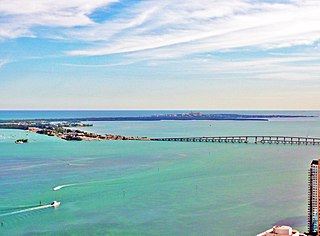
The Rickenbacker Causeway is a causeway that connects Miami, Florida to the barrier islands of Virginia Key and Key Biscayne across Biscayne Bay.

The Venetian Islands are a chain of artificial islands in Biscayne Bay in the cities of Miami and Miami Beach, Florida. The islands are, from west to east: Biscayne Island (Miami), San Marco Island (Miami), San Marino Island, Di Lido Island, Rivo Alto Island, and Belle Isle. Flagler Monument Island remains an uninhabited picnic island, originally built in 1920 as a memorial to railroad pioneer Henry Flagler. The islands are connected by bridges from the Miami mainland to Miami Beach.

Belle Isle is a neighborhood in the city of Miami Beach on an island in Biscayne Bay, Florida, United States. It is the easternmost of the Venetian Islands, a chain of artificial islands in Biscayne Bay in the cities of Miami and Miami Beach. It is home to apartment buildings, a portion of the Venetian Causeway, a city of Miami Beach park, and a hotel. It is between Rivo Alto Island and the main barrier island of Miami Beach.
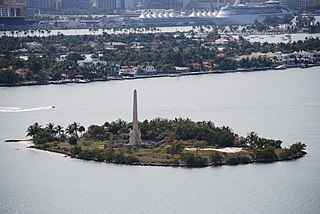
Flagler Memorial Island is an uninhabited artificial island of South Beach in the city of Miami Beach in Biscayne Bay, Florida. A 110-foot (34 m) high obelisk with allegorical sculptures at its base stands as a monument to Miami pioneer Henry M. Flagler, and was built in the center of the freshly constructed island in memory of Flagler, who died in 1913.

Palm Island is a neighborhood in the city of Miami Beach on a man-made island in Biscayne Bay, Florida, United States; just south of Hibiscus Island. It is a residential neighborhood with high property values, solely accessible by land via the MacArthur Causeway. The entire island has an area of 82 acres (33 ha).
The Picnic Islands are a small group of islands within the city of Miami, Florida, United States. They are located just north of Biscayne Island in Biscayne Bay, just east offshore from the Edgewater and Upper Eastside districts of the city. The islands are uninhabited, but several of the group have beaches where boaters and picnickers frequent.
The Arsenicker Keys or Arsnicker Keys may refer to any one of three groups of islands in southern Florida, in the United States. "Arsenicker", or "Arsnicker", is a corruption of "Marsh sneaker", a name used by Bahamians for the Great Blue Heron.

Margaret Pace Park is an 8-acre (3.2 ha) urban park located in the Arts & Entertainment District and Edgewater district of Greater Downtown Miami, Florida, U.S.A. The park is located on Biscayne Bay and has tennis courts as well as personal fitness equipment. It was created in the late 1960s and named in honor of Margaret Pace, who was a founder and past president of the Miami Garden Club. Pace was also chairwoman of Royal Palm State Park, which later became part of Everglades National Park, according to the Biscayne Times. A former vice president the Miami Women’s Club, which is located next door, Pace fought development of the adjoining bayfront green space, which became the park and was named in her honor, according to the Miami Herald. Directly across North Bayshore Drive, three large condominium complexes that were built in the 2000s housing an economic bubble overlook the park. The park underwent a $4 million renovation during this time. An even larger building is under construction adjacent the park As of 2015. The historic Miami Women's Club building is located directly to the south of the park.
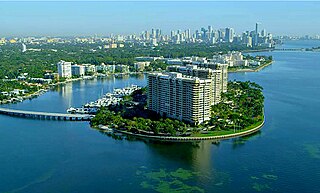
Grove Isle is a 20-acre (81,000 m2) island lying off the north-east coast of Miami's Coconut Grove neighborhood. Three waterfront hi-rise residences have been built on the island which were master-planned to include a resort hotel, restaurants, marina, club amenities and services.
References
- ↑ "Seasons in Miami: When Is the Best Time to Rent a Yacht?". 2024-10-04. Retrieved 2024-10-15.
- ↑ "The island that Miami forgot: Historic Bird Key teems with pelicans, egrets, ibises and trash" . Retrieved 2024-10-15.
- ↑ "Bird Key, rare rookery in Biscayne Bay, gets clean-up and shines again". Miami Herald. Retrieved 2024-10-15.
- ↑ "Bird Key Hits Market for $31.5 Million, Leaving Miami Wildlife Retreat in Limbo". Miami New Times. Retrieved 2024-10-15.